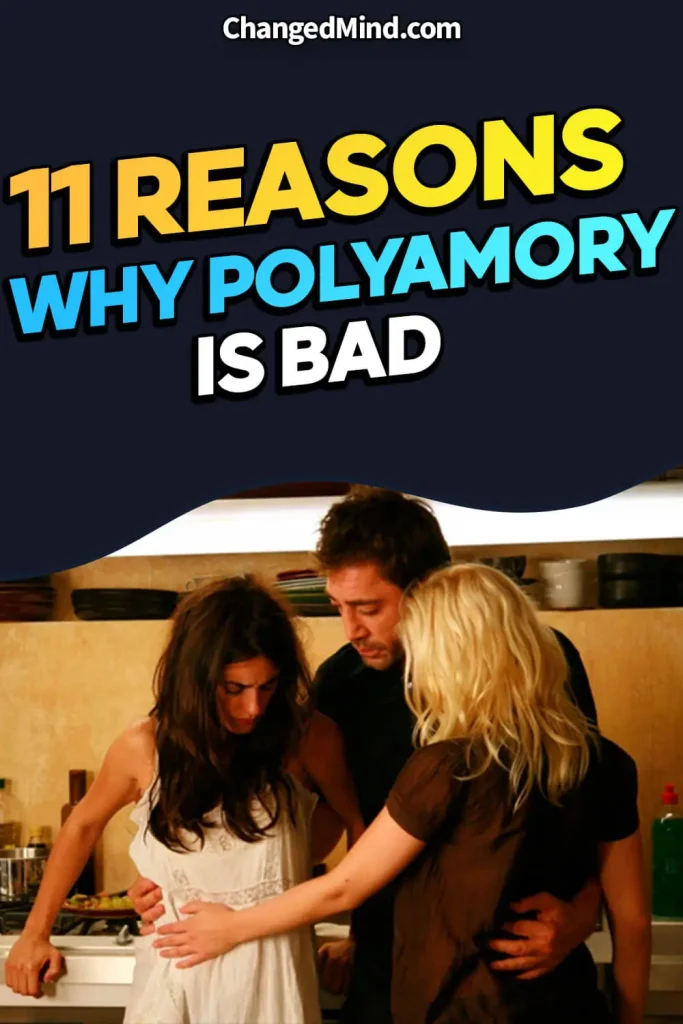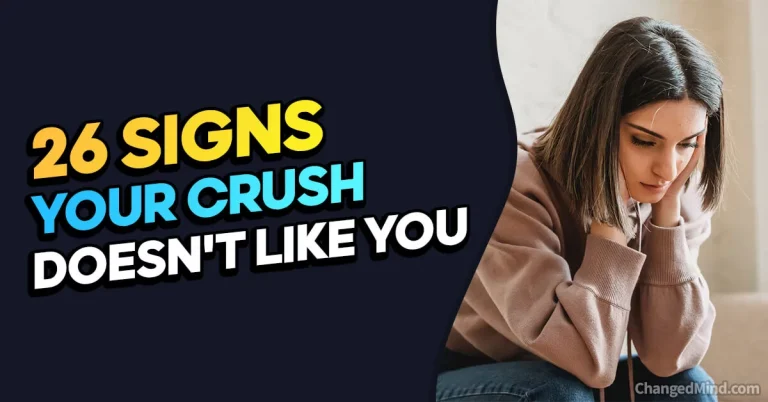Ready to dive into the kaleidoscope of love called polyamory? Well, hold onto your heart, because here comes the short answer for “Why Polyamory Is Bad”: It’s like trying to ride several rollercoasters at once, thrilling but nauseating! 🎢
Intrigued? Don’t swipe left just yet. Our whirlwind tour will swing by emotional complexity, jealousy, the dizzying juggle of time, financial quagmires, and a chorus of “What would Grandma think?” 🎠
So buckle up, love enthusiasts, as we unravel 11 honest reasons why polyamory might not be your carnival of dreams. 🍿🎪
Key Takeaway:
- Polyamory can lead to jealousy issues: Idealized notions of managing jealousy within polyamorous relationships often falter in reality, causing significant emotional distress.
- Emotional connection comes at a cost: The freedom to love multiple partners also comes with the potential for heartbreak and emotional investment, leading to further conflicts.
- Equality is impossible in practice: While some polyamorous relationships may strive for equality through open communication, sheer complexity and dynamics can hinder the practical realization of it.
What is Polyamory?
Definition of Polyamory
Polyamory, oh what a word! Derived from the Greek word “poly,” meaning many, and the Latin word “amor,” meaning love (apparently ancient civilizations couldn’t decide on one language, but who are we to judge?), polyamory is like a modern-day romantic buffet. Essentially, it’s being in a relationship with multiple partners with everyone’s consent. It’s like having your cake and eating others too.
But hey, before you jump on the Poly Express, be warned that this is not just about free love and wild parties. Polyamory requires oodles of communication, trust, and personal boundaries. It’s the opposite of monogamy, where you commit to just one person, like the traditional peanut butter & jelly sandwich. With polyamory, imagine having peanut butter, jelly, Nutella, honey, and maybe some avocado all in one sandwich. Yes, it’s crowded.
Brief historical background
Now, you might think that polyamory is as modern as that app on your phone that tells you how many steps your eyebrows moved today, but guess what? It’s been around for ages! Though the term itself was coined in the early ’90s (when grunge and flannel were all the rage), the concept is ancient.
In many cultures, ethical non-monogamy was pretty standard. For example, several tribal societies in ancient times allowed men to have multiple wives. However, the tables have turned, and polyamory now isn’t bound by gender; it’s a free-for-all.
In the 19th century, there was this thing called “complex marriage” in a community called Oneida, where everyone was married to everyone else. Yes, it sounds like a logistical nightmare.
Fast forward to the swinging ‘60s and ‘70s, when love was free, and so were, well, other things. Polyamory started to re-emerge amidst the sexual revolution, where traditional values were challenged by a tsunami of change.
Today, polyamory is still in a bit of a tussle with societal norms. There’s a delicate balance between personal happiness, commitment, emotional well-being, and societal acceptance.
So, now that you’re caught up with the 101 on polyamory, brace yourselves, because we’re about to delve into the nitty-gritty of why polyamory is bad. We’re talking jealousy, emotional intimacy, societal impact, and all that jazz. Trust me, it’s going to be a wild ride! 🎢
Stay tuned, grab your popcorn, and keep an open mind as we set sail on this intriguing journey through love, relationships, and the many reasons to think twice before taking the polyamorous plunge.
The Increasing Popularity of Polyamory
Current trends and statistics
Buckle up, lovebirds, because polyamory is taking flight! 🚀 Remember when monogamy was the golden standard for relationships? Well, times have changed, my friends. As the world embraces the buffet of life, people are sampling more dishes, and polyamory is on the menu.
Before we take a bite, let’s break down some numbers, shall we?
According to a study by the Journal of Sex & Marital Therapy, about one in five Americans have engaged in consensual non-monogamous relationships at some point. It seems like the ‘one size fits all’ approach to relationships is going out of fashion faster than a pair of bell-bottoms.
So, why is polyamory picking up steam? Many folks are eager to explore emotional intimacy and sexual ethics without being boxed into traditional norms. They’re saying, “Hey, monogamy! You’re not the boss of me!” 🙅♀️
However, polyamory isn’t a free ticket to the love-carnival. Like the most enticing rollercoaster, there are thrills and spills. And trust me, the spills can be messy.
Open-Minded Millennials and Gen Z
Let’s have a standing ovation for the Millennials and Gen Z, the brave generations putting monogamy through its paces. They’re saying adios to cultural perspectives that don’t jive with their ethos. These generations are all about fluidity in identity, love, and commitment.
In a 2020 YouGov poll, only 51% of Millennials said that their ideal relationship was completely monogamous. Gen Z was hot on their heels, questioning the very fabric of fidelity and loyalty.
Rise of Polyamory in Media
Pop culture is catching the polyamory bug, too. Turn on the TV or open a magazine, and you might find a non-monogamous couple canoodling on screen or discussing relationship dynamics. Series like House of Cards and You Me Her are feeding the polyamorous curiosity. It’s becoming more socially acceptable, or at least, a well-known phenomenon.
A Buffet of Relationships?
Now, before you throw caution to the wind and join the polyamory parade, it’s vital to be aware that it’s not all rainbows and unicorns. There are complex psychological effects, social acceptance battles, and good ol’ fashioned jealousy to deal with.
The number of polyamorous individuals might be on the rise, but we can’t ignore the reasons why polyamory is bad for some. So as we venture further, keep your eyes wide open, and let’s march ahead into the thick of it! 🕵️♂️
Spoiler alert: It’s a jungle out there. Tread with caution and a hearty supply of emotional bug spray.
Now, hold onto your heartstrings, because we’re about to explore the nitty-gritty of why polyamory is bad. From the strains on emotional well-being to the scrutiny of societal norms, you’ll want to be sitting down for this one. 🎢
Why Polyamory Is Bad: 11 Real Reasons

Welcome to the main event! You might want to take notes because we’re about to unravel the mind-boggling world of polyamory. So, why is polyamory bad, you ask? Here’s a crash course in the top 3 reasons.
Emotional Complexity
Managing multiple emotional bonds
Ah, emotions. Those pesky little things that make us human. Managing emotions with one partner is like juggling two oranges; now imagine juggling oranges, apples, and a watermelon. It’s like a fruit salad of the heart! 🍊🍎🍉
In polyamory, you’ve got multiple emotional bonds, which means you’re not just managing your emotions but also navigating the high seas of everyone else’s. That’s a Herculean task, my friend.
Think about it; every relationship requires emotional intimacy, communication, and support. When you multiply that, you’re upping the ante on emotional labor. There’s a high probability that someone feels neglected or overwhelmed. If emotions were currency, you’d be spending like a drunken sailor. Be careful not to bankrupt your emotional well-being!
Jealousy Issues
The strain on relationships
Now, let’s talk about the green-eyed monster called jealousy. We’ve all met it; it’s the uninvited guest at the party of love. In polyamorous relationships, jealousy can be like a photobomber in every picture. 📸
Contrary to popular belief, not all polyamorous folks are immune to jealousy. They’re not like jealousy wizards with protective shields. No siree!
Seeing your partner with someone else can lead to insecurity and strain in relationships. Jealousy is not just a feeling; it’s a sneaky villain, chipping away at the foundation of trust and happiness.
“Who’s that you’re texting?” “Why did you like their picture?” “You’re spending HOW much time with them?”
Jealousy’s questions never end, do they?
Time Management Struggles
Balancing multiple partners
Alright, take out your planners and calendars because this one’s a doozy. Time management – the mortal enemy of the polyamorous! ⏳
Imagine balancing work, hobbies, friends, and one relationship. Now throw in two or three more relationships. Oh, did I mention each relationship requires date nights, emotional support, anniversaries, and the occasional emergency ice cream runs?
That’s right; your schedule just turned into a Tetris game and the blocks are piling up fast.
Remember, your time and energy are finite. The more partners, the less time you can devote to each, and that’s a recipe for dissatisfaction soup with a side of resentment bread.
Balancing multiple partners is like trying to keep a dozen plates spinning at once. It’s not a matter of if they’ll crash, but when.
Risk of STIs
Increased exposure
Ahoy, Captain! 🏴☠️ We’re sailing into dangerous waters with this one. Polyamory comes with the risk of walking the plank, or in less pirate-y terms, increased exposure to sexually transmitted infections (STIs).
In a monogamous relationship, you have a safety net (provided both partners are exclusive and clean). In polyamory, you’re sailing on the high seas, docking at multiple ports. That’s a risky business!
Getting involved with more partners increases the likelihood of STIs, which isn’t just bad for your health but can also throw cannonballs at your relationships.
Anchors away, and don’t forget the protection!
Financial Strains
Expenses involved in multiple relationships
Ah, money, the universal language. 🤑 In polyamory, your wallet might start feeling like an overused accordion. Why? Because relationships are an investment, my dear Watson.
Valentine’s Day? Ka-ching! Birthdays? Ka-ching! Anniversaries? You guessed it, ka-ching!
Now multiply that by the number of partners. Congratulations! You now have an overworked calculator and a trembling bank account.
Maintaining multiple relationships requires digging deep into those pockets, and unless you’re the lost heir to a billion-dollar fortune, it might not be sustainable in the long run.
Social Stigma
Facing societal judgment
Let’s talk about the elephant in the room – social stigma. 🐘
When you say “polyamory”, some people might react like you said “Voldemort”. It’s the relationship style that must not be named! Polyamory doesn’t exactly fit the societal norms of traditional relationships and marriage.
Folks in polyamorous relationships often face the judgmental glare of society’s magnifying glass. The whispers, the side-eye, the “But think of the children!” exclamations. It’s like being a celebrity without the fancy perks.
So, if you’re not keen on joining the ranks of social rebels, polyamory might not be the golden ticket you’re looking for.
Parenting Challenges
Raising children in polyamorous relationships
Remember when we talked about juggling emotions? Well, throw in a few kids and you’ve got yourself an emotional Cirque du Soleil. 🎪
Children are like sponges; they absorb everything – the good, the bad, and the complicated. Raising kids in a polyamorous relationship can be a labyrinth of challenges. From explaining the family dynamics to dealing with legal implications and potential insecurities.
Additionally, co-parenting with multiple partners can be like trying to solve a Rubik’s cube blindfolded. Whose house will the kids stay at? How will decisions be made? It’s a family values puzzle that can be daunting to piece together.
Legal Complications
Marital and Property Issues
Polyamory: a relationship style more tangled than earbuds in your pocket. Now, let’s add legal complications into the mix! 📜⚖️
Imagine playing a game of Monopoly where no one knows the rules. Well, that’s polyamory in the eyes of the law. Traditional marriage laws are built around two players, not an entire team.
But you, my adventurous friend, have decided to throw caution to the wind and run a multiplayer marathon. Who gets the house? Who inherits? What if there’s a breakup? The legal world of marital and property rights hasn’t quite caught up with polyamory, leaving you to navigate a labyrinth of complexity.
Impact on Mental Health
Psychological Effects
The brain is a finicky creature, much like a cat that wants attention but also space. 🐱 Polyamory can have a meow-tain of impact on mental health.
Balancing multiple relationships can be as delicate as diffusing a bomb while riding a unicycle. Throw in jealousy, commitment issues, and insecurity, and you’ve got a cocktail of emotional turbulence. Research suggests that those in polyamorous relationships might experience higher levels of stress and anxiety.
So, ask yourself: “Is my emotional well-being ready for a roller coaster ride?”
Relationship Instability
Long-term Sustainability
Alright, let’s cut to the chase. Is polyamory the kind of relationship that can last longer than a pint of ice cream on a bad day? 🍨
Polyamory can be as stable as a Jenga tower in an earthquake zone. While not all polyamorous relationships are destined to crumble, the added dynamics create a house of cards that can be hard to sustain. Managing the expectations and happiness of multiple partners is like herding cats.
This, my friend, is where the dream of endless love can start to feel like an endless maze. Is it worth it? Only you can decide.
Potential for Exploitation
Manipulative Dynamics
Let’s venture into the dark side of polyamory, where some folks use the poly-label as a cape for ulterior motives. 🦹♂️
The very nature of polyamory — based on consent and ethical non-monogamy — can be exploited by those with a penchant for manipulative dynamics. There’s a fine line between consensual polyamory and someone just trying to have their cake and eat it too.
Without clear communication and personal boundaries, one can find themselves caught in a web of exploitation, mistaking it for love.
So, wield your Polyamory Shield with caution and be ever vigilant for signs of deceit!
The Final Word
Polyamory, it’s not all rainbows and butterflies. It’s a complicated soup of emotions, legal issues, and potential pitfalls. But you, intrepid love explorer, are now armed with 11 honest reasons why polyamory is bad. So, before you set sail into the stormy seas of polyamory, make sure your ship is sturdy and you have a clear map. May your quest for love be true and your compass steady! 🏹❤️🗺️
Hold On, There’s More…
Well, we’ve only just scratched the surface of why polyamory is bad. Stay tuned as we continue to unveil the other side of polyamory, navigating the stormy waters of legal complications, psychological effects, and much more.
Grab your life jackets; it’s going to be a wild ride! 🌊
Conclusion
Summarizing the Reasons
Now that we’ve journeyed through the “Why Polyamory Is Bad” jungle, let’s set up camp and make sense of the wild ride. 🏕️
In our expedition, we unearthed some thorny issues:
- Emotional Complexity: Juggling multiple emotional bonds could be like trying to solve a Rubik’s Cube blindfolded.
- Jealousy Issues: When green-eyed monsters start gnawing at your relationships, it’s not a picnic.
- Time Management Struggles: Balancing time between partners could feel like an Olympic sport – and not everyone’s going for gold.
- Risk of STIs: More partners, more chances for cooties to make their way into your fortress.
- Financial Strains: More partners can be like a subscription service gone wild – but there’s no easy “unsubscribe” button.
- Social Stigma: Society can often be the “judgy aunt” we never asked for.
- Parenting Challenges: Managing parenting in polyamory is like directing a play where no one has read the script.
- Legal Complications: Marital and property issues that are trickier than a magician’s hat.
- Impact on Mental Health: Psychological effects as varied as flavors in a soda machine.
- Relationship Instability: Some polyamorous relationships wobble like a toddler learning to walk.
- Potential for Exploitation: There can be wolves in sheep’s clothing in the poly-world.
Encouraging Informed Choices
Here’s the grand finale, my poly-curious compadre. 🎆
Armed with this treasure trove of insights, you stand at the crossroads. Polyamory can be as enchanting as a siren’s song but beware the rocky shores. If the poly-life beckons, pack your bags with communication, trust, and a mega-load of emotional intelligence.
But, if you’re like a cat on a hot tin roof just thinking about it, maybe traditional monogamy is your cozy fireside chair.
There’s no one-size-fits-all in the wardrobe of love. The key is to make informed choices that suit your heart’s threads. So don your explorer’s hat and choose the path that’s right for you with wisdom, grace, and a dash of daring.
Happy love trails to you, intrepid traveler! ❤️🔍🗺️
Some Facts About Why Polyamory Is Bad: 11 Honest Reasons:
- ✅ Polyamorous relationships can lead to jealousy, even if polyamorous people claim they don’t get jealous. (Source: Team Research)
- ✅ Emotional connections are inevitable in polyamorous relationships and can lead to heartbreak if one partner falls in love with someone else more than their primary partner. (Source: Team Research)
- ✅ Equality is difficult to achieve in practice in polyamorous relationships, especially in hierarchical relationships where some partners may feel less important than others. (Source: Team Research)
- ✅ Emotional investment in relationships cannot be divided equally between multiple partners, leading to feelings of neglect or favoritism. (Source: Team Research)
- ✅ Power struggles can occur in polyamorous relationships, with competition and egos getting in the way. (Source: Team Research)

FAQs about Why Polyamory Is Bad
Why is polyamory becoming more popular?
Polyamorous relationships have existed since the beginning of time, but they have gained popularity lately due to ethical non-monogamy becoming more socially acceptable. More people are exploring alternative relationship arrangements.
What are the advantages of polyamorous relationships?
Polyamorous relationships can provide increased opportunities for emotional intimacy, personal growth, and sexual exploration. With consensual non-monogamy, partners can maintain honesty and openness in their relationships while avoiding the confines of traditional societal norms.
What are the disadvantages of polyamorous relationships?
Some disadvantages of polyamorous relationships include dealing with jealousy and managing emotional connections with multiple partners. Equality can be challenging to achieve in practice, and power struggles can arise. There can also be legal issues to consider in western cultures, where marriage to more than one person is illegal.
What is the poly community?
The poly community consists of people who identify as polyamorous or engage in consensual non-monogamous relationships. This includes individuals in open relationships, one-sided open relationships, and polyfidelity arrangements.
Is polyamory an unhealthy or toxic emotion?
No, polyamory is not an unhealthy or toxic emotion. It is a consensual relationship arrangement that allows individuals to explore multiple romantic and sexual connections with the knowledge and consent of all involved parties.
What is compersion in polyamorous relationships?
Compersion is a term used in polyamorous relationships to describe the feeling of joy or happiness that one partner experiences when their partner is romantically or sexually involved with someone else.
Disclaimer
This information is for educational purposes only and is not intended to be a substitute for clinical care. Please consult a health care provider for guidance specific to your case.






